Multimodal Raman, Photoluminescence & SHG Imaging of CVD Grown WSe2
Key Points
- Multimodal imaging using one instrument and one software package to fully characterise layer-dependent optoelectronic properties in 2D materials
- Raman imaging for resolving monolayer and multilayer WSe2
- Photoluminescence imaging to probe the areas of multilayer crystal showing regions of bilayer and trilayer WSe2
- Second Harmonic Generation imaging to determine layer orientation of multilayer WSe2
Two-dimensional transition-metal dichalcogenides are a class of layered semiconducting materials that exhibit unique layer-number-dependent optical and electronic properties. In this application note, we will discuss how the RMS1000 Confocal Mircoscope enables multimodal imaging of tungsten diselenide (WSe2), with five multimodal imaging options: reflected brightfield & darkfield, Raman, photoluminescence and second harmonic generation to fully characterise its layer-dependent optoelectronic properties.
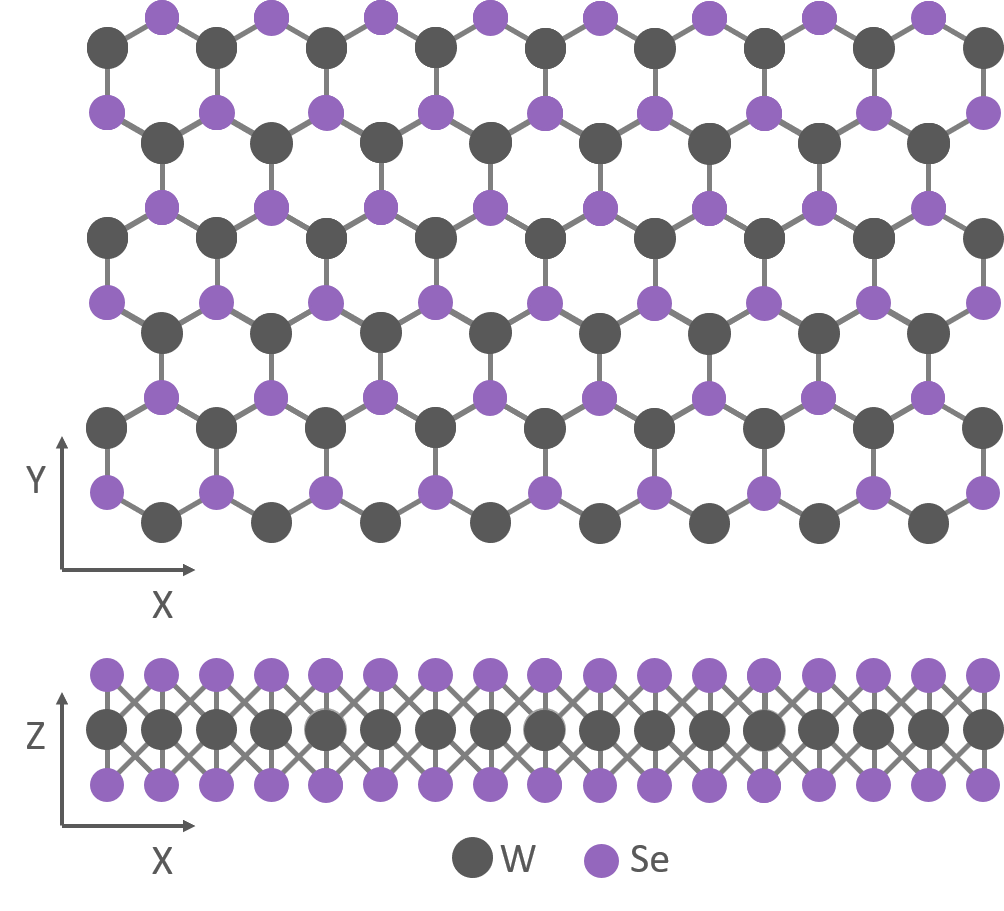
Figure 1: Monolayer WSe2 Crystal Structure.
Materials & Methods
WSe2 crystals were grown on a Si substrate using chemical vapour deposition (CVD) and characterised using an Edinburgh Instruments RMS1000 Confocal Microscope. The RMS1000 was equipped with a 100x NA 0.9 objective and a back-illuminated CCD camera. For Raman and photoluminescence imaging, the WSe2 was excited with a 532 nm laser using a 1800 gr/mm and 300 gr/mm diffraction grating to acquire the Raman and photoluminescence spectra respectively. For second harmonic generation (SHG) imaging, a Chromacity 1040 HP femtosecond fibre laser (Chromacity Ltd. UK) operating at 1040 nm and 80 MHz was coupled to the RMS1000 for excitation, and the SHG response was acquired using a 300 gr/mm diffraction grating.
 Figure 2: Edinburgh Instruments RMS1000 Multimodal Confocal Microscope.
Figure 2: Edinburgh Instruments RMS1000 Multimodal Confocal Microscope.
Reflected Brightfield and Darkfield Imaging
The WSe2 crystal was first widefield imaged using reflected brightfield and darkfield (Figure 3). In the reflected brightfield image, the reflective silicon substrate appears bright and the absorbing WSe2 crystal deposited atop is darker. Nucleation sites appear as dark spots across the crystal surface, as well as a stronger absorbing domain in the centre that is suggestive of multilayer WSe2.
Reflected darkfield imaging provides complementary information. In darkfield, the sample is illuminated at an oblique angle and steps in sample surface height cause increased scattering and appear bright in the image. The darkfield image reveals there are two regions in the central domain with different heights, likely due to different WSe2 layer numbers.
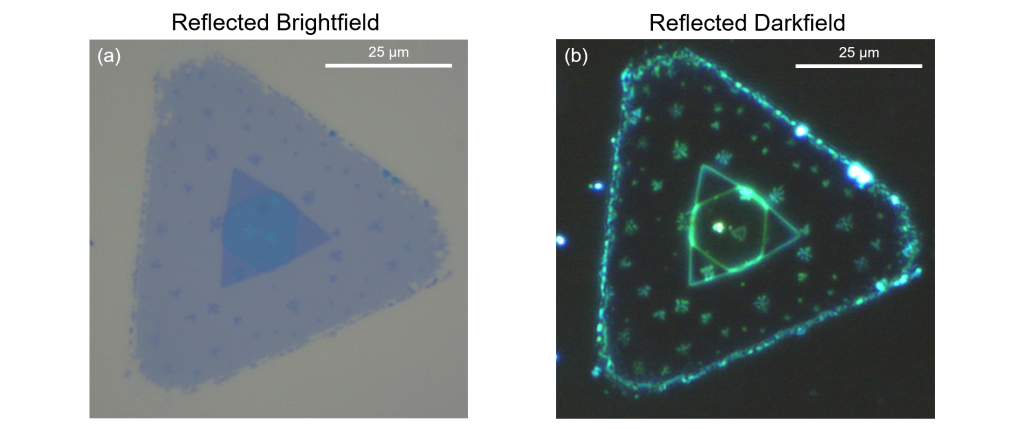
Figure 3: (a) Reflected brightfield and (b) reflected darkfield imaging of the WSe2 crystal.
Raman Imaging
The crystal was next Raman imaged (Figure 4). WSe2 has a characteristic Raman peak at 250 cm-1 (Figure 4d) which corresponds to the in-plane E12g and out-of-plane A1g phonon modes of WSe2. In contrast to other transition-metal dichalcogenides, the E12g & A1g phonon modes are almost degenerate in WSe2 and are not individually resolved, with both contributing to the 250 cm‑1 peak.1,2 In the centre of the crystal, an additional peak at 310 cm-1 is observed (marked with arrows in Figure 4d). This peak is symmetry forbidden in monolayer WSe2 and indicative of multilayer WSe2.2
The E12g / A1g peak intensity (Figure 4a) is highest in the large primary triangle domain, and reduces by ~80% within the inner triangle domain. The reduction in E12g / A1g intensity is indicative of a change from monolayer to multilayer WSe2.1 The E12g / A1g peak position (Figure 4b) shifts from 250 cm-1 in the primary domain to 247 cm-1 within the inner domain which supports a change in layer number.3 The E12g / A1g peak also shifts towards higher wavenumbers at the edges of the crystal which is attributed to changes in the local microenvironment at the disordered edges.
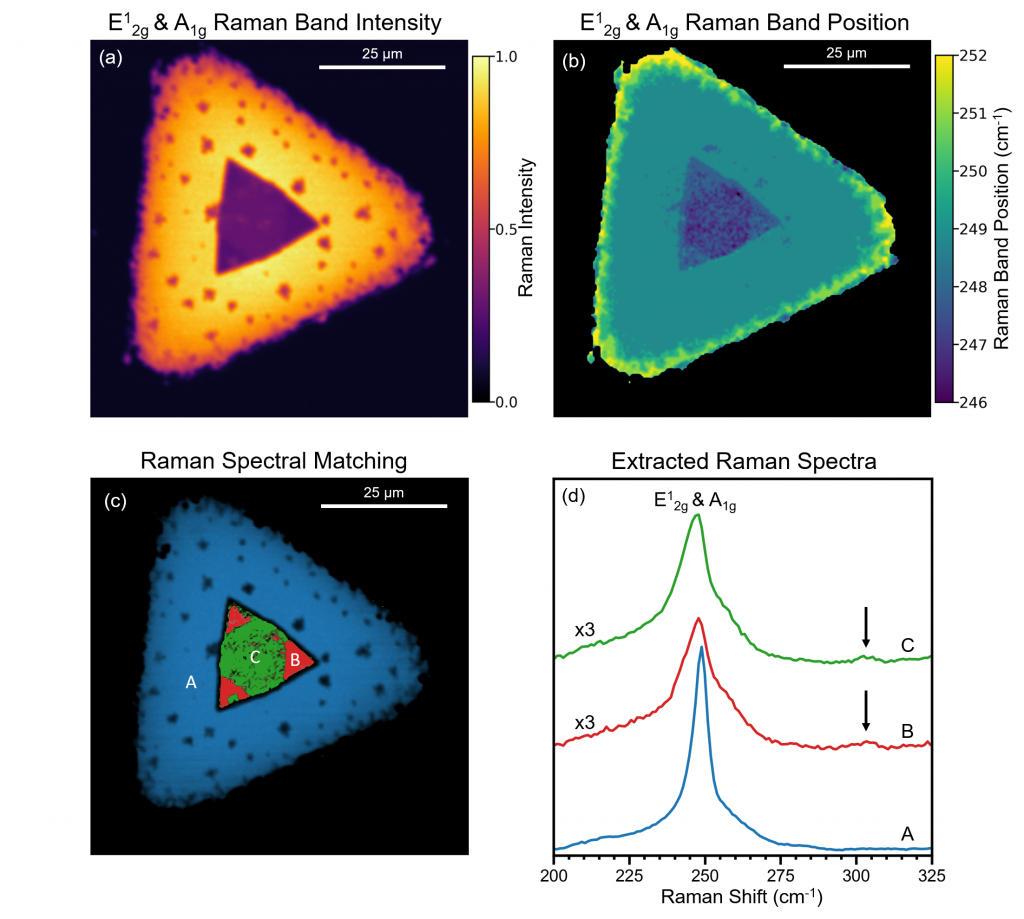 Figure 4: Raman imaging of WSe2. (a) Intensity of the E12g / A1g (250 cm-1) Raman band, (b) peak position of the E12g / A1g Raman band, (c) least squares spectral matching revealing three distinct Raman spectral areas, (d) averaged Raman spectra from areas A, B and C; spectra B and C are scaled in intensity by a factor of three and the arrows mark the location of the multilayer 310 cm-1 peak. The Raman imaging parameters were: 40 x 40 μm2, 200 x 200 pixels, 50 ms integration time, 532 nm laser, 1800 gr/mm diffraction grating, 300 μm pinhole.
Figure 4: Raman imaging of WSe2. (a) Intensity of the E12g / A1g (250 cm-1) Raman band, (b) peak position of the E12g / A1g Raman band, (c) least squares spectral matching revealing three distinct Raman spectral areas, (d) averaged Raman spectra from areas A, B and C; spectra B and C are scaled in intensity by a factor of three and the arrows mark the location of the multilayer 310 cm-1 peak. The Raman imaging parameters were: 40 x 40 μm2, 200 x 200 pixels, 50 ms integration time, 532 nm laser, 1800 gr/mm diffraction grating, 300 μm pinhole.
Ramacle® spectral matching analysis (Figure 4c) identified three distinct Raman spectral regions in the crystal. In spectral matching, spectra at user-selected locations in the map are designated as archetypes and the deviation of all other spectra in the map from the archetype is calculated. Lower deviations from the archetype spectra are represented by more intense colour. The monolayer WSe2 primary domain is highlighted in blue while the inner domain was found to be composed of two regions (highlighted in red and green) with subtly different E12g / A1g Raman peak shapes. This agrees with the change in surface height in the inner domain observed in the darkfield image.
Photoluminescence Imaging
To obtain additional insight into the inner domain, the crystal was photoluminescence (PL) imaged (Figure 5). The total PL intensity (Figure 5a) is lower within the inner domain, and the PL peak position (Figure 5b) red-shifted. Spectral matching (Figure 5c) identified four distinct PL spectral regions across the crystal and their corresponding spectra are shown in Figure 5d.
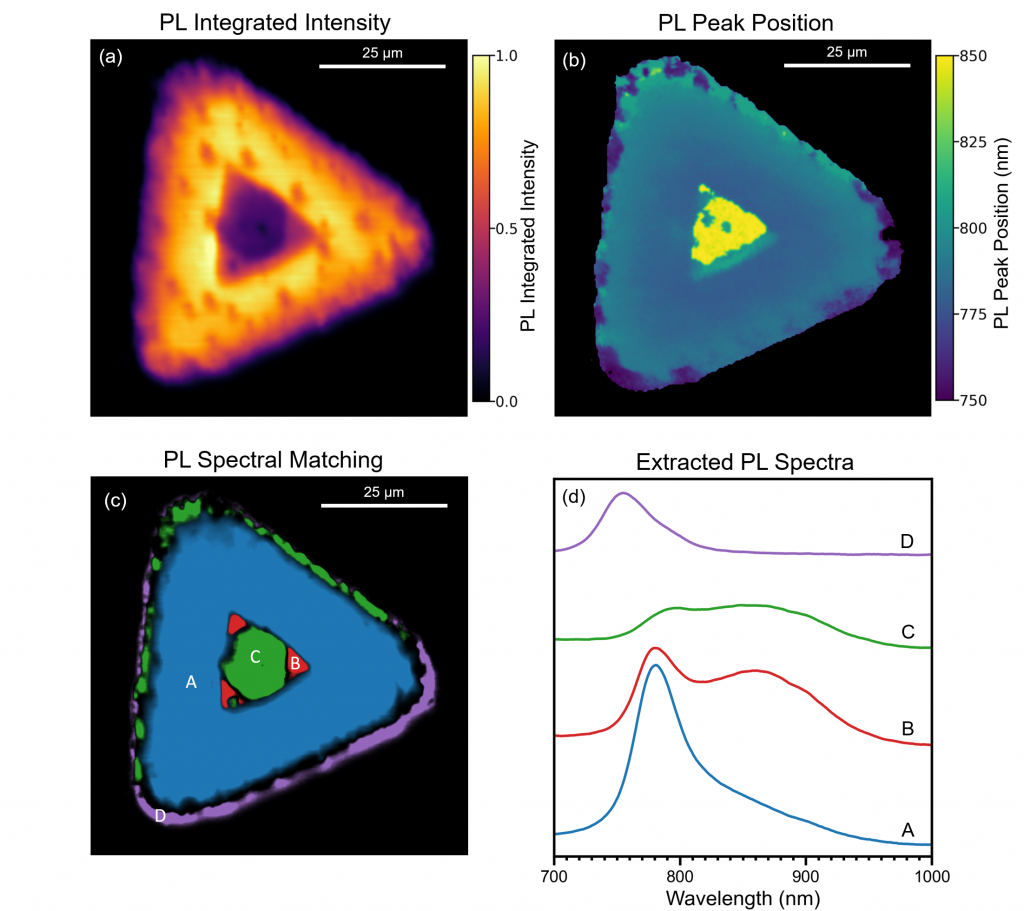 Figure 5: Photoluminescence imaging of WSe2. (a) Integrated intensity of the PL response, (b) PL primary peak position, (c) least squares spectral matching revealing four distinct PL spectral areas, (d) averaged PL spectra from areas A, B, C and D. The PL imaging parameters were: 40 x 40 μm2, 200 x 200 pixels, 30 ms integration time, 532 nm laser, 300 gr/mm diffraction grating, 300 μm pinhole.
Figure 5: Photoluminescence imaging of WSe2. (a) Integrated intensity of the PL response, (b) PL primary peak position, (c) least squares spectral matching revealing four distinct PL spectral areas, (d) averaged PL spectra from areas A, B, C and D. The PL imaging parameters were: 40 x 40 μm2, 200 x 200 pixels, 30 ms integration time, 532 nm laser, 300 gr/mm diffraction grating, 300 μm pinhole.
Region A (blue) is monolayer WSe2 with PL peak at 780 nm from confined exciton emission. In region B the total PL intensity is decreased with a longer wavelength shoulder peak at 870 nm, while in region C the PL intensity decreases further and spectral weight shifts to the long wavelength shoulder. It has been established that as the number of layers increases in WSe2, the PL emission red-shifts from exciton based emission at ~1.6 eV (~780 nm) in the monolayer to indirect bandgap emission at ~1.2 eV (~1000 nm) in bulk WSe2.1 Region B and C are therefore assigned as bilayer and trilayer WSe2 respectively. Similarly to the Raman image, significant edge effects were also observed in the PL, with the PL peak position blue-shifted on the lower edge (spectrum D) and red-shifted on the upper edge of the crystal.
Second Harmonic Generation Imaging
To determine the layer orientation within the three identified domains, the crystal was imaged using second harmonic generation (SHG) (Figure 6). SHG imaging is highly sensitive to the crystalline symmetry of transition metal dichalcogenides, with SHG only occurring when there is a non‑centrosymmetry in the excitation focal volume. Monolayer WSe2 is non-centrosymmetric and region A has a measurable SHG response as expected. The symmetry of multilayer WSe2 depends on the type of layer stacking, 2H or 3R.5 In 3R stacking, each layer has the same orientation and the multilayer is non-centrosymmetric with SHG response increasing with layer number. In contrast, in 2H stacking, each layer is rotated 180° with respect to the adjacent layers and odd-numbered multilayers are net non-centrosymmetric with an SHG response similar to the monolayer while even-numbered multilayers are net centrosymmetric with no SHG response.4,5
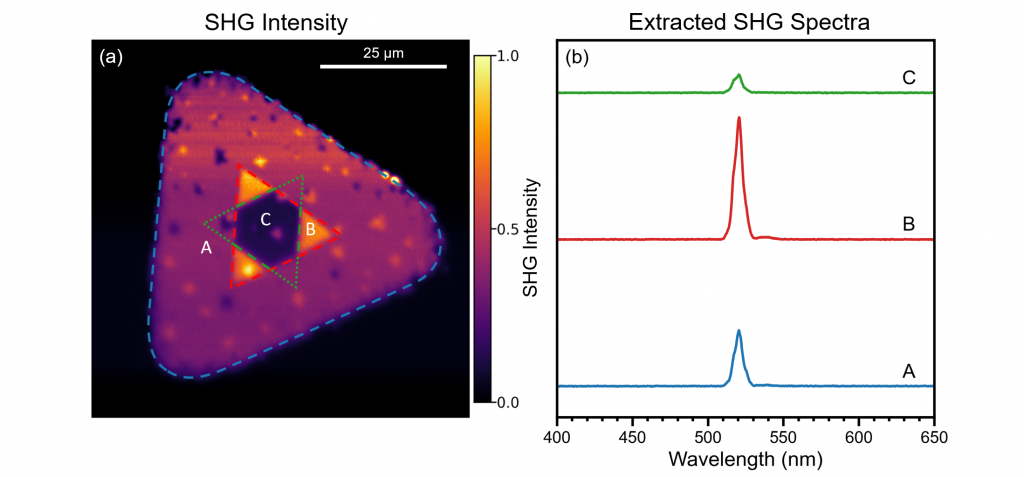
Figure 6: Second Harmonic Generation imaging of WSe2. (a) Intensity of the SHG peak at 520 nm. (b) extracted SHG response from areas A, B, and C. The SHG imaging parameters were: 40 x 40 μm2, 200 x 200 pixels, 11 ms integration time, 1040 nm femtosecond pulsed laser, 300 gr/mm diffraction grating, 300 μm pinhole.
The bilayer WSe2 in region B has an SHG response that is twice that of the monolayer, and the two layers therefore must be 3R stacked. The trilayer WSe2 in region C has diminished SHG response compared to the monolayer which indicates the third layer in the trilayer is rotated relative to the first and second layers resulting in a partial restoration of centrosymmetry. The blue, red and green dashed triangles in Figure 6a illustrate the relative orientations of the three layers in the crystal. The growth of the third layer (green) has terminated at the boundaries of the second layer (red) resulting in a partial triangle.
Conclusion
Through a combination of widefield, Raman, PL and SHG imaging techniques, the layer number and stacking type in a CVD-grown WSe2 crystal was identified. The multimodal imaging capabilities of the RMS1000 Confocal Microscope make it an ideal imaging platform for studying the optoelectronic properties of transition-metal dichalcogenides.
References
- Todddorf et al., Photoluminescence emission and Raman response of monolayer MoS2, MoSe2, and WSe2, Express, 2013, 21, 4908-4916
- Ribeiro-Soares et al., Second Harmonic Generation in WSe2, 2D Mater., 2015, 2, 045015
- Terrones et al., New First Order Raman-active Modes in Few Layered Transition Metal Dichalcogenides, Rep., 2014, 4, 4215
- Zhao et al., Atomically phase-matched second-harmonic generation in a 2D crystal, Light Sci. Appl., 2016, 5, e16131
- Shinde et al. Stacking-controllable interlayer coupling and symmetric configuration of multilayered MoS2, NPG Asia Mater., 2018, 10, e468
Keep in Touch
If you have enjoyed this application note about the multimodal imaging of WSe2 , be sure to subscribe to our newsletter and follow us on social media using the links below.









